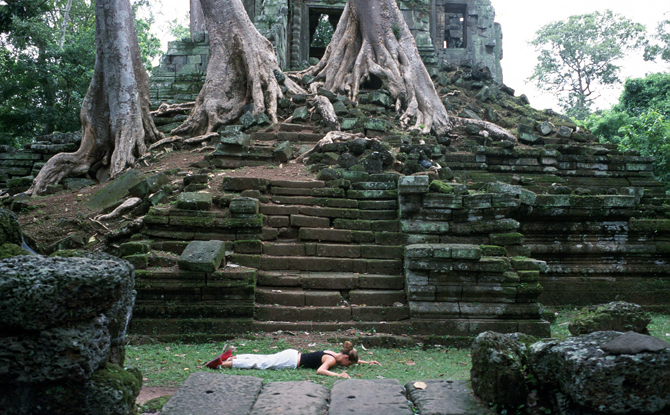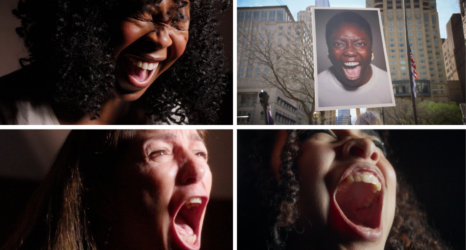Live Dangerously, on display now at the National Museum of Women in the Arts, is a breathtaking challenge of the possibilities—representing the female image freed from constraints of artistic history with its traditional display of women as part of the scenery.

Far from “gendered associations of eroticism and fertility,” this provocative exhibition reveals the female figure positioned in ways and in places unimagined. At once fierce and dreamy, this dynamic display by a dozen women photographers are sculptural poses revealing bold narratives.
No space is left uncovered in the main gallery, where Janaina Tschäpe’s series of 100 large-scale photographs,“100 Little Deaths” (1996-2002), is being shown together for the first time in an immersive installation. Each image depicts the artist lying down—in beaches, on forest floors, on bridges, in stairways, in hotel rooms. The body in each startling in its stark contrast to its surroundings whether on the floor next to a yellow sofa in “Living Room,” or a mere dot on the landscape against the line up of “Moais.”
Pioneer fashion photographer Louise Dahil-Wolfe’s surreal “California Desert” (1948) and “Dappled Nude” (1940) pose professional models in the nude in the wild terrain of the Mojave Desert, where their subtle curves blend with the barren landscape, while Laurie Simmons’ “Water Ballet (Vertical)” (1981) captures the synchronized swimming choreography of mid twentieth century Hollywood films and the folklore of mermaids.
“Ice Pedestal” series (2015) is the work of Kirsten Justesen, an ice sculptor and body-art pioneer, while Ana Mendieta’s “Volcan” series (1979) is “earth-body sculptures.” Mendieta outlined herself in gunpowder in a volcano-like mound, which was set aflame to create a hazy silhouette, the eventual charred remains blending with the terrain.
The entire planet is a possible locale for these intrepid women. Justine Kurland’s teen-aged girls engage in environments as varied as “Smoke Bombs,” “Jungle Gym,” “Slumber Party,” “Self Portrait, “Casper, Texas, Canyon” and “Waterfall, Mama Babies.” Dana Hoey’s settings are for bounty hunters like old cowboy films, with “Helldorado” (1999) from her series “Phoenix.” Rana Matar focuses on when woman most often leave home in their early twenties. to face unforgiving landscapes as spread across the planet as Miami Beach, Beirut, Cairo.
Singular works speak up, too. Anna Gaskell evokes a mysterious story world in “Untitled #104 (A Short Story of Happenstence);” Graciela Iturbide for the realistic faces of the Seri people in “Mujer Ángel, Desierto de Sonora (Angel Woman, Sonoran Desert).” Mwangi Hutter’s “For the Last Tree” represents her ecological concerns. Xaviera Simmons focuses on the racial caste system in a self-portrait—in trench coat, curly Afro and blackface, set in a thicket of reeds—in “One Day and Back There (Standing).”
Live Dangerously, with its daring scenarios, in vibrant colors, of these works of earthly life, is a fitting pendant to Judy Chicago’s reflections in adjacent galleries at the National Museum of Women in the Arts. It is open at NMWA until January 20, 2020.





